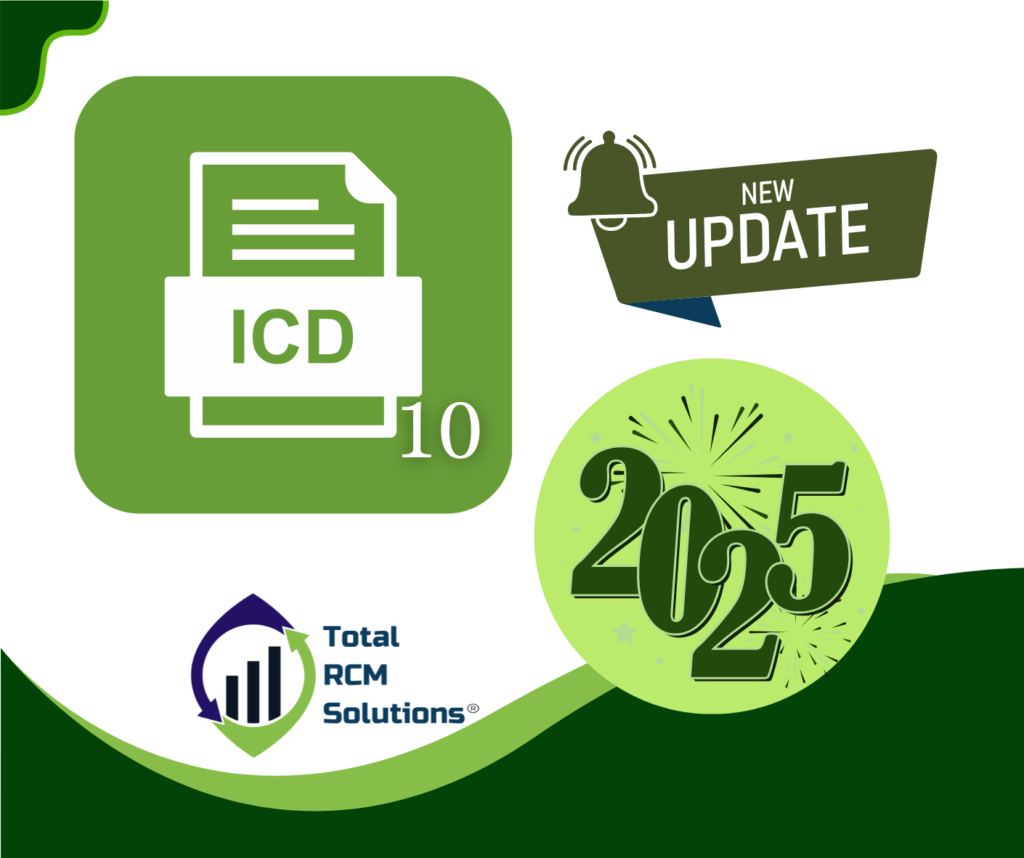The Center for Medicare and Medicaid services has released the FY 2025 updates to the ICD 10 CM Code classification. There are fewer new codes this year compared to last year, but many interesting new codes are being added.
| Year | New Codes | Deleted Codes | Revised Code Title |
| 2025 | 252 | 34 | 13 |
| 2024 | 395 | 25 | 13 |
The list below highlights some of the significant 2025 updates to ICD-10-CM by chapter.
Chapter 1 – There are no new codes in this chapter for certain infectious and parasitic diseases but A77.41 is revised to correct the spelling of “chaffeensis.”
Chapter 2: Neoplasms
- The codes in categories C81-C84 now have an option to report “in remission”.
- The codes in categories C86 and C88 now have options to report “not having achieved remission” or “in remission.”
Chapter 3 – Just one new code is added here: D61.03 Fanconi anemia.
Chapter 4: Endocrine, Nutritional and Metabolic Diseases.
Three new subcategories of codes have been added
- E10.A- Type 1 diabetes mellitus, presymptomatic
- E16.A- Hypoglycemia level
- E66.8 – Obesity class.
Four additional new codes have been added to this chapter, Several subcategories have new instructional notes that direct reporting of additional codes for use of injectable non-insulin antidiabetic drugs (Z79.85) and/or new codes from subcategory E16.A- Hypoglycemia level.
Chapter 5: Mental, Behavioral and Neurodevelopmental Disorders.
- The codes in category F50 Eating Disorders that report anorexia, bulimia and binge eating have been expanded to specify severity.
- The diagnoses of PICA and rumination disorder have new codes specifically reporting these conditions in adults.
Chapter 6 – There are several changes under G40 Epilepsy and recurrent seizures including the addition of G40.84 KCNQ2-related epilepsy and four child codes (G40.841-G40.844) to specify whether or not the disease is intractable, with status epilepticus. There are also new codes for serotonin syndrome (G90.81), other disorders of the autonomic nervous system (G90.889), and developmental and epileptic encephalopathy (G93.45).
Chapter 7 – In this chapter, five fifth-character codes under H44.2 Degenerative myopia are revised to remove the reference to bilateral “eye.”
Chapter 8 – There are no changes for diseases of the ear and mastoid process (H60-H95).
Chapter 9 – Four new codes (I26.03-I26.04, I26.95-I26.96) expand the I26 Pulmonary embolism subcategory, and two existing codes (I26.93-I26.94) are revised to add the term “thrombotic.”
Chapter 10 – Under subcategory J21 Acute bronchiolitis there are several new codes for nasal valve collapse. The sixth-character codes specify the location of the collapse (internal/external) and the seventh character codes describe state of the condition (static/dynamic/unspecified).
Chapter 11: Diseases of the Digestive System – Codes in category K60 Fissure and fistula of anal and rectal regions have been expanded to specify complexity and nature of occurrence. Several instructional notes have also been added directing the assignment of codes for associated diagnoses.
Chapter 12 – Under L29 Pruritus, there are new codes for cholestatic pruritus (L29.81) and other pruritus (L29.89). And under L43 Lichen planus, six new fifth-character codes more fully describe lichen planopilaris (L66.10-L66.12, L66.19) and central centrifugal cicatricial alopecia (L66.81, L66.89).
Chapter 13: Diseases of the Musculoskeletal System and Connective Tissue.
Codes for lumbar and lumbosacral intervertebral disc degeneration (M51.36 and M51.37) have been expanded to specify type of pain as
- discogenic back pain only
- lower extremity pain only
- discogenic back pain and lower extremity pain
- without mention of lumbar back pain or lower extremity pain
- Excludes 1 notes have been added excluding these codes from being reported with codes M54.3, M54.4 and M54.5.
- Code M65.9 Synovitis and tenosynovitis has been expanded to include specification of site and laterality.
Chapter 14 – Other than the addition of an Excludes1 note under N39.0 Urinary tract infection, site not specified, there’s nothing exciting going on here.
Chapter 15 – This chapter has a few note changes to codes in subcategory O24 Diabetes mellitus in pregnancy, childbirth, and the puerperium.
Chapter 16 – There is the addition of one Excludes1 note under P72 Other transitory neonatal endocrine disorders.
Chapter 17 – In this chapter, there are three new codes for congenital malformations of aortic and mitral valves (Q23.81Q23.82, Q23.88) and one new code for Kleefstra syndrome (Q87.86).
Chapter 18 – You’ll find one new code here for anosognosia (R41.85). Patients with this condition are unaware of their health conditions or problems, often due to dementia or Alzheimer’s.
Chapter 19: Injury, Poisoning and Certain Other Consequences of External Causes.
- Category T45 Poisoning by, adverse effect of and underdosing of primarily systemic and hematological agents, NEC is getting 6 new codes to report poisoning by, adverse effect of and underdosing of immune checkpoint inhibitors and immunostimulant drugs. o
- Code T81.32 Disruption of internal operation (surgical) wound, not elsewhere classified is being expanded to include four new codes to provide greater specificity in reporting disruption or dehiscence of internal operation or surgical wounds.. o
- Various instructional notes related to these two groups of new codes can be found in the Tabular List for Chapter 19 and other chapters of ICD-10CM.
Chapter 20 – There are no changes in this chapter for external causes of morbidity.
Chapter 21: Factors Influencing Health Status and Contact with Health Services
- Category Z17 is being updated from Estrogen receptor status to Estrogen, and other hormones and factors receptor status and 8 new codes are being added to indicate positive/negative receptor status and/or combined receptor status.
- A new subcategory of codes has been added
Z67.A- Duffy phenotype.
- Other updates to Z codes that include new or revised codes include
- Z15.- genetic susceptibility to disease
- Z51.A Encounter for sepsis aftercare
- Z59.7- Insufficient social insurance and welfare support
- Z68.5- Body mass index [BMI] pediatric
- Z83.72 Family history of familial adenomatous polyposis
- Z26.101- Personal history of colonic polyps
Reference: https://www.cms.gov/medicare/coding-billing/icd-10-codes


